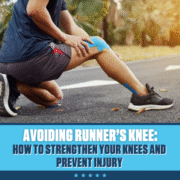Avoiding Runner’s Knee: How to Strengthen Your Knees and Prevent Injury
Whether you’re logging your first few miles or training for your next half marathon, knee pain can be one of the biggest obstacles for runners. “Runner’s knee,” or patellofemoral pain syndrome, is a common overuse injury caused by stress on the knee joint. The good news? With the right strengthening exercises, form checks, and recovery habits, you can keep your knees healthy and your stride strong.
1. Strengthen Supporting Muscles
Your knees rely on surrounding muscles—especially your quads, hamstrings, glutes, and calves—for stability. Building strength in these areas helps absorb impact and reduce stress on the joint. Try adding these exercises to your weekly routine:
-
Squats and lunges: Build balanced lower body strength and improve alignment.
-
Glute bridges: Strengthen the glutes, which stabilize the hips and knees.
-
Calf raises: Support proper shock absorption during running.
-
Leg lifts: Target the quads without adding too much joint strain.
 2. Focus on Running Form
2. Focus on Running Form
Small adjustments in your stride can make a big difference. Keep your knees slightly bent on impact, avoid overstriding, and ensure your foot lands under your hips—not far in front of you. Maintaining a strong core helps with posture and reduces uneven pressure on your knees.
3. Don’t Skip Warm-Ups and Cool-Downs
Dynamic stretches before a run (like leg swings or high knees) get your joints ready for movement, while static stretches afterward (like quad or hamstring stretches) help maintain flexibility. This routine keeps your muscles loose and your knees better supported.
 4. Listen to Your Body
4. Listen to Your Body
If you start feeling knee pain, don’t push through it. Reduce your mileage, cross-train with low-impact workouts like swimming or cycling, and ice the affected area. Early attention to discomfort prevents small issues from becoming serious injuries.
5. Invest in the Right Gear
Worn-out or ill-fitting shoes can throw off your alignment and add strain to your knees. Replace running shoes every 300–500 miles, and consider a gait analysis at a local running store to find the best shoe for your stride.
 Keep Your Knees Strong All Season Long
Keep Your Knees Strong All Season Long
Knee health is essential to running longevity—take the time to strengthen, stretch, and recover properly so you can enjoy every mile pain-free. Train smart, protect your knees, and you’ll be ready to take on your next challenge with confidence.
Ready to put your training to the test?
Join us at the Spurs Austin International Half Marathon this January 18, 2026 and show off all that hard work.



